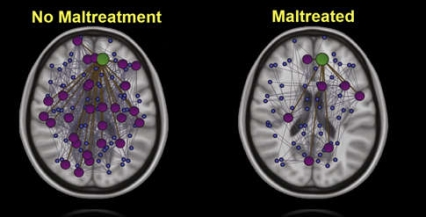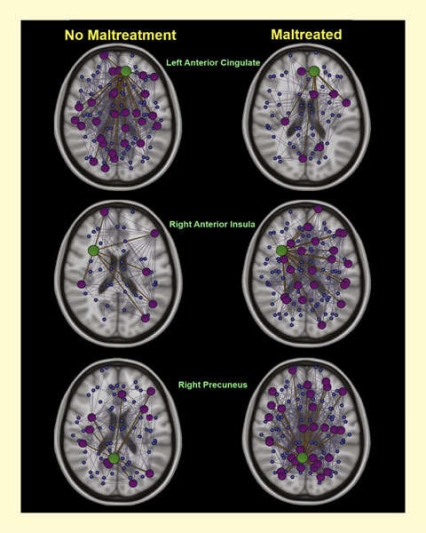Childhood maltreatment alters children’s brain development in ways that may increase their risk for substance use and other mental disorders in adulthood. In a NIDA-supported study, researchers found that young adults who had been maltreated as children differed from others who had not been maltreated in the connectivity of nine cortical regions. The differences could compromise the maltreated group’s basic social perceptual skills, ability to maintain a healthy balance between introversion and extroversion, and ability to self-regulate their emotions and behavior.
Dr. Martin Teicher and colleagues at McLean Hospital, Harvard Medical School, and Northeastern University, performed magnetic resonance imaging (MRI) on 265 young adults, ages 18 to 25. Based on the young people’s responses on a battery of screening instruments, including the Traumatic Antecedents Interview and the Childhood Trauma Questionnaire, the researchers determined that 123 had experienced physical or emotional abuse, neglect, or sexual abuse as children.
The researchers compared the maltreated participants’ MRI images with those of the 142 participants who had not been maltreated. Their analysis showed that maltreatment was associated with alterations in cortical network architecture, reflected in marked differences in the centrality of nine brain regions, and in the set of regions that constituted the network’s “rich club”:
- Centrality comprises a series of measures that indicate the relative importance of a cortical region within the network. Degree centrality is the number of direct connections a node has to other nodes. Betweenness centrality reflects the number of times a node lies along the shortest pathway between two other nodes. Eigenvector centrality is a more complex measure of importance and is similar to Google’s page rank algorithm. Regions with greater centrality exert more influence on communication within the network than those with lesser centrality.
- Rich clubs are neural hubs connecting well-connected (highly centralized) cortical regions with each other. The rich clubs serve as the communication backbone for the network.
The Affected Regions
The greatest maltreatment-associated connectivity changes were seen in two regions that work together to mediate perception and regulation of emotions and urges (see Figure). The right anterior insula, which is involved in integrating and coordinating awareness of internal feelings and urges, such as craving, was a centralized region and a rich club member in the maltreated participants but not in the controls. The left anterior cingulate, which participates in the regulation of emotions and impulses, was a highly centralized region and a rich club member in the controls, but not in those with a history of maltreatment.
“Increased centrality of the anterior insula may lead to more intense craving for drugs coupled with diminished insight into the consequences of such use. Decreased centrality of the anterior cingulate may lead to reduced ability to control impulses or to make appropriate decisions based on past outcomes,” says Dr. Teicher. “This indicates that the altered cortical connectivity in maltreated individuals may put them at much greater risk for addiction if they start down the road of drug use.”
The researchers also noted that the right precuneus, a region associated with self-centered thinking, had high centrality and rich club membership in the maltreated study participants but not in the controls. In contrast, the middle frontal gyrus, which is implicated in working memory, attention, and self-knowledge had decreased centrality among maltreated participants. This region was also not a rich club member in the maltreated participants, although it was in the controls. Those who were maltreated also showed decreased centrality compared with those who were not maltreated in the:
- Temporal pole, which supports the attribution of thoughts, intentions, or beliefs to others
- Occipital pole, which supports visual processing and conscious awareness
- Superior parietal gyrus, which supports working memory
- Precentral gyrus and sulcus, which supports motor coordination and sensory perceptions.
The researchers assessed centrality and determined rich club memberships by measuring thickness in 112 cortical areas on MRI scans, and then calculated the degree to which thickness measures between regions correlated across subjects in maltreated and control groups. Regions that correlate strongly in thickness are either directly connected by fiber tracts or functionally coupled. The researchers used graph theory to calculate measures of centrality and rich club membership from the interregional correlations (see Brain Network Architecture Reflects Experience).
The study’s findings suggest that childhood maltreatment is a severe stressor that alters trajectories of brain development. Regions involved in monitoring internal awareness of emotions become highly connected hubs and thereby may more strongly influence a person’s behavior. At the same time, regions that control impulses become less connected and are relegated to a less central role in the network. These changes may set the stage for an increased risk for substance use and other mental health disorders throughout life.
This study was supported by NIH grants DA016934 and DA017846.
Source:
Teicher, M.H.; Anderson, C.M.; Ohashi, K. et al. Childhood maltreatment: altered network centrality of cingulate, precuneus, temporal pole and insula. Biological Psychiatry. 76(4):297-305, 2014. Full text
Brain Network Architecture Reflects Experience
Graph theory is a new approach to analyzing the role of specific brain regions in communication networks. In the present study, researchers determined the interconnectedness of 112 cortical regions by assessing correlations in thickness measures between regions. A highly positive correlation in thickness between two brain regions indicates that the regions are directly or functionally coupled. Graph-theoretical analysis was then used to delineate the network architecture from the interregional connectivity pattern. A diagram generated with these data traces the number of direct and indirect connections from a region of interest to other areas of the brain. This gives a measure of the region’s connectedness and influence across the whole brain.
Researchers visualize brain architecture in this way to study the impact of the environment on the course of brain network development. For example, by comparing findings in people exposed to stressful events in childhood with those in people without these negative experiences, researchers can investigate whether these negative childhood events are associated with shifts in centrality, or importance, of specific brain regions in network communications. This approach has also been used to identify network abnormalities in mental disorders and diseases, such as schizophrenia, epilepsy, multiple sclerosis, and Alzheimer’s disease.
- Text Description of Graphic
-
The figure shows three panels comparing brain network architectures in the cortex between young adults who were maltreated as children (right column) and those who were not (left column). The comparison at the top panel shows that the left anterior cingulate (circled in green) has much lower direct (purple circles) and indirect (blue circles) connections to other cortical regions in those who were maltreated than in those who were not maltreated as children. The middle panel shows much higher direct and indirect connectivity from the right anterior insula to other cortical regions in those maltreated than those not maltreated. And the lower panel shows a much higher number of direct and indirect connections from the right precuneus to other cortical brain regions in those who were maltreated than in those not maltreated.


